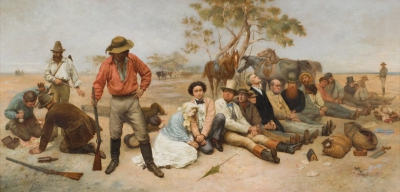Edward Kelly (December 1854 11 November 1880), better known as Ned Kelly, was an Australian bushranger, outlaw, gang leader and convicted police-murderer. One of the last bushrangers, he is known for wearing a suit of bulletproof armour during his final shootout with the police.
Kelly was born in the then-British colony of Victoria as the third of eight children to Irish parents. His father, a transported convict, died shortly after serving a six-month prison sentence, leaving Kelly, then aged 12, as the eldest male of the household. The Kellys were a poor selector family who saw themselves as downtrodden by the Squattocracy and as victims of persecution by the Victoria Police. While a teenager, Kelly was arrested for associating with bushranger Harry Power, and served two prison terms for a variety of offences, the longest stretch being from 1871 to 1874 on a conviction of receiving a stolen horse. He later joined the "Greta mob", a group of bush larrikins known for stock theft. A violent confrontation with a policeman occurred at the Kelly family's home in 1878, and Kelly was indicted for his attempted murder. Fleeing to the bush, Kelly vowed to avenge his mother, who was imprisoned for her role in the incident. After he, his younger brother Dan, and two associatesJoe Byrne and Steve Hartshot dead three policemen, the Government of Victoria proclaimed them outlaws.
Kelly and his gang eluded the police for two years, thanks in part to the support of an extensive network of sympathisers. The gang's crime spree included raids on Euroa and Jerilderie, and the killing of Aaron Sherritt, a sympathiser turned police informer. In a manifesto letter, Kellydenouncing the police, the Victorian government and the British Empireset down his own account of the events leading up to his outlawry. Demanding justice for his family and the rural poor, he threatened dire consequences against those who defied him. In 1880, when Kelly's attempt to derail and ambush a police train failed, he and his gang, dressed in armour fashioned from stolen plough mouldboards, engaged in a final gun battle with the police at Glenrowan. Kelly, the only survivor, was severely wounded by police fire and captured. Despite thousands of supporters attending rallies and signing a petition for his reprieve, Kelly was tried, convicted and sentenced to death by hanging, which was carried out at the Old Melbourne Gaol.
Historian Geoffrey Serle called Kelly and his gang "the last expression of the lawless frontier in what was becoming a highly organised and educated society, the last protest of the mighty bush now tethered with iron rails to Melbourne and the world". In the century after his death, Kelly became a cultural icon, inspiring numerous works in the arts and popular culture, and is the subject of more biographies than any other Australian. Kelly continues to cause division in his homeland: some celebrate him as Australia's equivalent of Robin Hood, while others regard him as a murderous villain undeserving of his folk hero status. Journalist Martin Flanagan wrote: "What makes Ned a legend is not that everyone sees him the sameit's that everyone sees him. Like a bushfire on the horizon casting its red glow into the night."
Bushrangers were originally escaped convicts in the early years of the British settlement of Australia who used the bush as a refuge to hide from the authorities. By the 1820s, the term had evolved to refer to those who took up "robbery under arms" as a way of life, using the bush as their base.
Bushranging thrived during the gold rush years of the 1850s and 1860s when the likes of Ben Hall, Bluecap, and Captain Thunderbolt roamed the country districts of New South Wales. These "Wild Colonial Boys", mostly Australian-born sons of convicts, were roughly analogous to British "highwaymen" and outlaws of the American Old West, and their crimes typically included robbing small-town banks and coach services. In certain cases, such as that of Dan Morgan, the Clarke brothers, and Australia's best-known bushranger, Ned Kelly, numerous policemen were murdered. The number of bushrangers declined due to better policing and improvements in rail transport and communication technology, such as telegraphy. Although bushrangers appeared sporadically into the early 20th century, most historians regard Kelly's capture and execution in 1880 as effectively representing the end of the bushranging era.
Bushranging exerted a powerful influence in Australia, lasting for over a century and predominating in the eastern colonies. Its origins in a convict system bred a unique kind of desperado, most frequently with an Irish political background. Native-born bushrangers also expressed nascent Australian nationalist views and are recognised as "the first distinctively Australian characters to gain general recognition." As such, a number of bushrangers became folk heroes and symbols of rebellion against the authorities, admired for their bravery, rough chivalry and colourful personalities. However, in stark contrast to romantic portrayals in the arts and popular culture, bushrangers tended to lead lives that were "nasty, brutish and short", with some earning notoriety for their cruelty and bloodthirst. Australian attitudes toward bushrangers remain complex and ambivalent.

1880Jun, 28
Australian bushranger Ned Kelly is captured at Glenrowan.
Choose Another Date
Events on 1880
- 13Feb
Edison effect
Thomas Edison observes the Edison effect. - 13May
Thomas Edison
In Menlo Park, New Jersey, Thomas Edison performs the first test of his electric railway. - 7Jun
Battle of Arica
War of the Pacific: The Battle of Arica, the assault and capture of Morro de Arica (Arica Cape), ends the Campaña del Desierto (Desert Campaign). - 28Jun
Ned Kelly
Australian bushranger Ned Kelly is captured at Glenrowan. - 11Nov
Ned Kelly
Australian bushranger Ned Kelly is hanged at Melbourne Gaol.

 English
English  español
español  français
français  português
português  русский
русский  العربية
العربية  简体中文
简体中文 